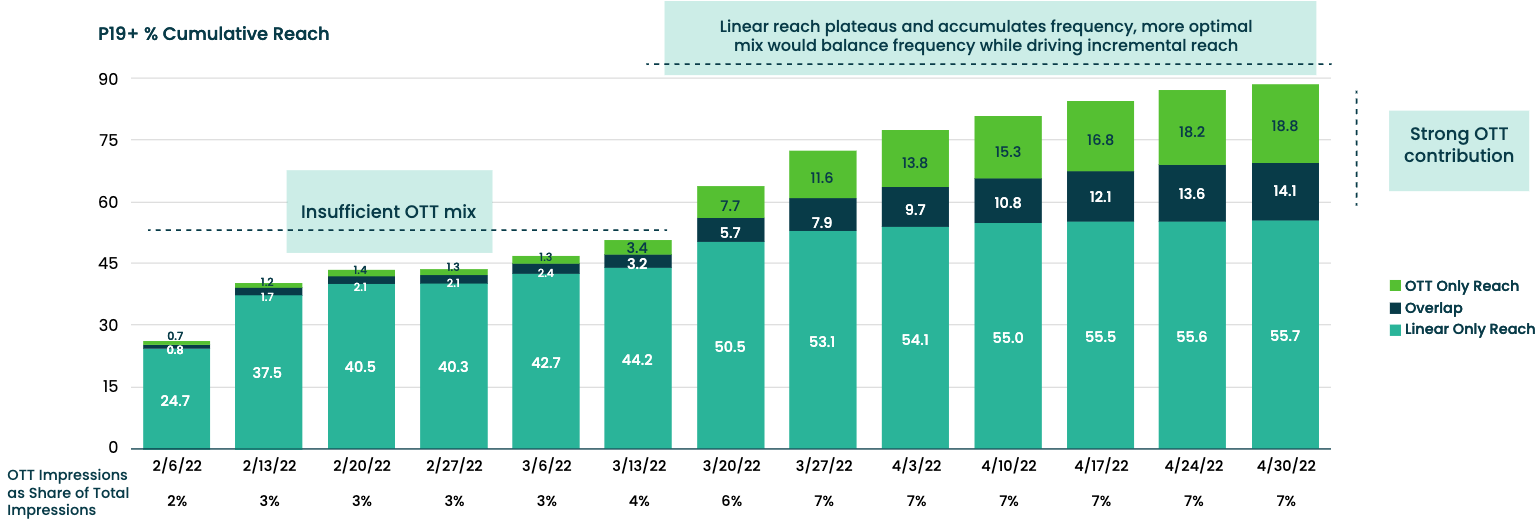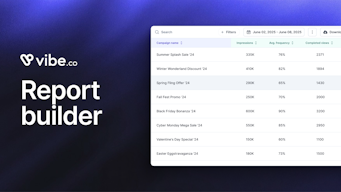The Meaning and Measurement of Incremental Reach
As the customer journey continues to fracture and digital channels and screen types multiply, incremental reach measurement is increasingly important to advertisers across channels, but especially for CTV ad budgets. Incremental measurement is meant to help advertisers gauge how much additional reach their CTV ad campaigns are garnering on top of their other digital media and linear TV campaigns. It does so by contrasting the outcomes achieved with CTV advertising against those they would have attained without it. This assessment is particularly valuable in the present advertising landscape, marked by stringent budget scrutiny and the growing opacity of campaign measurement metrics.
What is incremental reach and why is it so important?
Why is incremental reach measurement so crucial? It has a profound impact on optimizing ad spend and enhancing advertising efficacy - failing to grasp the benefits of CTV's incremental advantages can be costly. Many advertisers still rely heavily on linear TV, often overspending on duplicated impressions while overlooking cord-cutting audiences. This results in a wasteful allocation of resources and a dilution of advertising effectiveness.
Recent cross-platform research, such as NBCU and iSpot's currency test and learn initiative, underscore this issue. Their findings revealed that, on average, less than 10% of streaming impressions were harnessed by the 67 advertisers who participated in the study. Yet an optimal strategy actually involves allocating 30-40% of impressions to CTV to broaden reach and mitigate excessive frequency on linear platforms. This research echoes earlier results from a larger eMarketer survey that found advertisers still sorely underspending on CTV if they want to meaningfully increase their incremental reach.

In essence, incremental reach measurement illuminates the untapped potential of CTV advertising, which allows advertisers to efficiently reach audiences that elude traditional linear ads. Streaming TV advertising (aka CTV) is a powerful tool that empowers advertisers to make data-driven decisions, optimize their advertising strategies, and make the most of their advertising investments in an increasingly complex and competitive landscape.
How can advertisers measure incremental reach?
After years of scrutiny and data analysis, the evidence is unequivocal: CTV advertising closes the impressions gap for TV marketers. The pressing issue now is how to harness the power of CTV effectively, optimizing budget allocation across all TV channels. Achieving this requires the use of accurate, high-quality campaign measurement data and a clear understanding of the terminology involved.
Randomized Control
One approach to measuring CTV incrementality is randomized control versus exposed testing. This technique involves a meticulously selected target audience that receives a brand's CTV ad, while a control group, generated with identical audience attributes, does not receive the ad. Unlike other measurement methods like PSA (Public Service Announcement) testing or geo testing, this approach doesn't require extensive upfront planning or exorbitant budgets. Moreover, it lends itself well to an evergreen, always-on approach to incrementality measurement. With randomized control versus exposed testing, you have the opportunity to establish an ongoing, always-on test. This type of reporting is characterized by its simplicity—no upfront planning is required, and there are no activation costs. Most importantly, it isolates all variables except for ad exposure, ensuring the utmost accuracy in your results. For many brands, PSA or geo-based incrementality testing simply isn't as feasible.
Representative Data Set
Another powerful way to measure incremental lift from a CTV campaign is to leverage a substantial and representative TV dataset. This method involves comparing the group exposed to a CTV ad with a population that mirrors them in every way, from their demographic attributes to the types of TV shows they watch. The only distinguishing factor is that this control population has not been exposed to your ad. By scrutinizing the timing and exposure of TV ads and identifying who has been reached and who hasn't, you can strategically deliver relevant digital or CTV ads. This holistic approach to identifying and targeting audiences enables advertisers to capitalize on the segments missed by linear TV exposure, thereby achieving a significant and effective incremental reach.
Omniscreen Targeting
Embracing an omniscreen approach unlocks several targeting options without the need for extravagant spending on linear TV inventory. Here are four strategic avenues to help maximize incremental reach:
- Retarget elusive and underexposed audiences: Prioritize audiences that are typically underexposed to linear TV campaigns, including cord-cutters and light TV viewers. Focusing on this underexposed population enhances your incremental reach and optimizes the frequency of reaching households that may be overlooked through traditional linear targeting.
- Leverage digital and mobile targeting: Allocate a substantial portion of your budget to engage audiences on addressable digital devices like smartphones, laptops, and tablets. Second-screen attention is a force to reckon with, especially in TV advertising, as 87% of CTV viewers report looking at a second screen while watching TV. Notably, campaigns that leverage second-screen targeting have witnessed remarkable successes, with ad recall and conversion rates soaring by more than 200%.
- Think differently about tentpole events: Tentpole sporting or entertainment events, while enticing, come with their share of challenges: limited inventory, prohibitive pricing, and declining viewership in linear-only categories. Rather than funneling substantial chunks of your ad budget into linear tentpole events, consider a more cost-effective and complementary digital strategy. Incrementality can be achieved by adopting a divide-and-conquer game plan, effectively targeting premium audiences wherever their attention may be. This means staying above the noise and within budget by reaching viewers during and after broadcasts through CTV apps and digital devices.
- Establish clear goals and key performance indicators (KPIs) for your CTV advertising efforts. Define your testing audiences meticulously, set campaign dates and creative assets with precision, and seek a CTV ad partner who can provide the right data and insights to inform your decisions.
Valuing incremental reach in CTV advertising is a necessity in today's media landscape. By employing techniques like randomized control versus exposed testing and leveraging comprehensive TV datasets, advertisers can unlock the full potential of CTV while maintaining cost-effectiveness.
Embracing an omniscreen approach and strategically targeting elusive audiences, utilizing digital and mobile channels, and selecting tentpole events wisely (if at all) will further bolster your incremental campaigns. The path to success in CTV advertising is paved with data-driven decisions and a commitment to delivering impactful campaigns to the right audiences.
CTV MVP for Incremental Goals
In the ever-evolving landscape of digital media, where audiences are inundated with a multitude of choices across numerous devices and countless channels, advertisers face a formidable challenge: reaching their target viewers effectively. Because CTV allows advertisers to precisely target audiences across channels, it has transformed the way media buys are planned and priced.
While the rise of Mobile and Social Media has shed much ink, TV advertising remains by far the most compelling channel for reach (and now engagement, thanks to targeted CTV campaigns). Research from FreeWheel recently revealed that only a mere 10% of overall ad views originate from mobile devices, while an impressive 77% take place on the big screen.
These figures put a finer point on CTV’s massive reach and engagement potential, especially as cord cutters outpace viewers hanging on to their cable subscriptions.
Moreover, campaign industry data collected over the past two years unequivocally establishes that CTV not only hosts a substantial audience but, crucially, a significant portion, ranging from 30% to 50%, represents purely incremental reach when compared to Linear TV. This incrementality is especially pronounced among younger demographics, which are traditionally more challenging to reach through conventional channels.
Some industry leaders have even suggested that Linear TV, not CTV, should take on the mantle of “incremental player par excellence” since CTV and digital video align more seamlessly with various stages of the marketing funnel. Advertisers can harness the power of verified, privacy-compliant, cookieless household IDs, complemented by extensive omnichannel inventory partnerships. This holistic approach allows advertisers to connect the dots, navigating from brand awareness to purchase intent, ultimately fostering brand loyalty.
Connected TV, in concert with other digital platforms, fosters deeper and more meaningful engagements with consumers.


